When Engelbert Drerup arrived in Athens in February 1896 after a tiring journey from Italy, he was immediately immersed in the boisterous greek Carnival activities underway at the DAI: “At the Institute, right away I met Mr. Dörpfeld, Mr. Wolters, and Mr. Wilhelm, i.e. the leading figures at the German and Austrian station, the first of whom invited me right away to a Carnival-themed social evening at the Institute. […] and in the evening at the Dörpfelds’ I was introduced to the amusing antics of the young German scholars, who came in the Greek national costume with the fustanella: Fredrich, the future son-in-law of Wilamowitz, as a shy young lady; Wiegand as her sprightly husband, and Schrader and Dragendorff as their towering twin sons” (Drerup 1939, 163). Hans Dragendoff, the travel scholarship recipient just mentioned, wrote about the same event to his parents on February 17, 1896: “Lent began today. On Friday there was a ball at the Wolters’; yesterday, a party at the Dörpfelds’, where there also was dancing. Since it was Carnival (Fastnacht), we four grant recipients went dressed in the Greek national costume. We looked grand; the costume fits us marvelously. We dressed little Fredrich up as a farmer’s wife. A good many of the guests came in masks and we amused ourselves” (DE DAI-RGK-A-Fa-Drag-04, p. 43. This travel account in letters was kindly brought to my attention by Sandra Schröer, RGK).
We learn more about the other guests from an entry in Dörpfeld’s guestbook. Other archeologists were invited, as well as acquaintances from the “Deutsche Community,” including several young ladies (fig. 1).
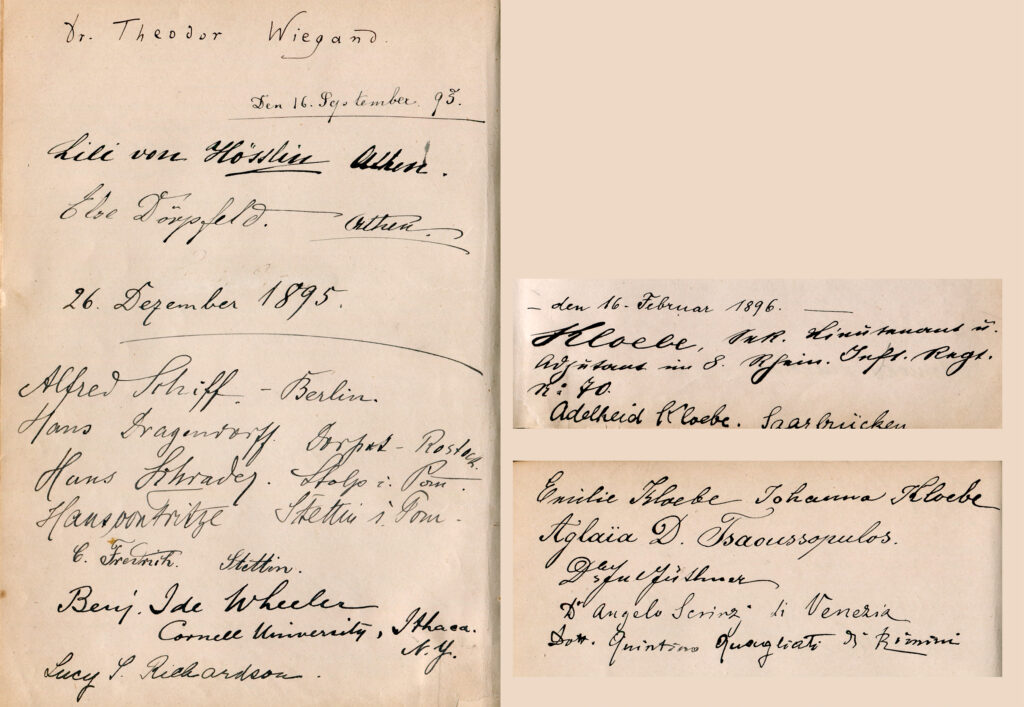
Dragendorff referred to the masquerade party again in his next letter home: “I am sending you some photographs (…). First, our palikaria-picture [palikaria are stately young men – editor], which the Institute photographer quickly took on the day after the party. The order is the following: Schrader, Fredrich, Wiegand and myself. The clothing is handsome, isn`t it? And those are not even costumes, but the same clothing that the people still wear by and large in the countryside. We found it at the bazaar; the merchant lent it to us. I would have liked to keep the women’s jacket. It had really fabulous old embroidery. I supposedly looked the most authentic. My haircut was especially well-suited. That is just how the farmer’s boys wear theirs.” (DE DAI-RGK-A-Fa-Drag-04, p. 46–47)
This photograph is unfortunately no longer extant. We can get an idea, however, of how young Germans looked in the Greek national costume from a picture showing Wilhelm Dörpfeld and his brother Hans (fig. 2).
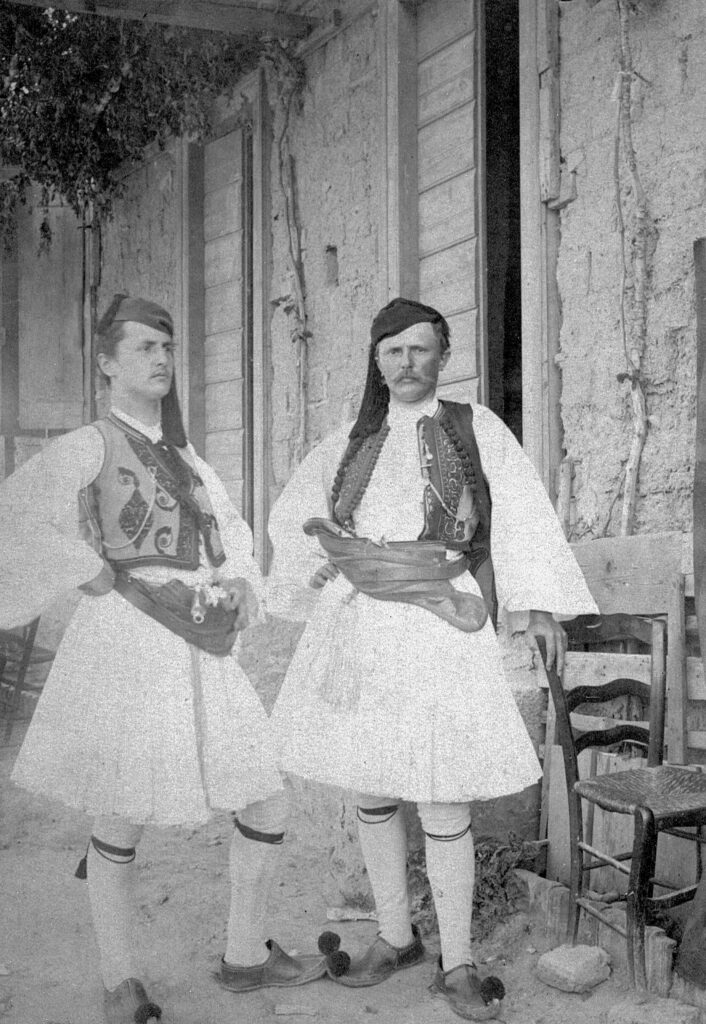
A photograph of the group of young archeologists with Dragendorff and Drerup, who came to Athens in 1895/1896 as travel grant recipients or on research trips, was recently published by the Roman German Commission of the DAI (RGK 2012,12).
Of the persons mentioned above, only Dragendorff has thus far been identified in photographs in our holdings (fig. 3). This is in part due to the fact that Schrader and Wiegand left Athens for excavations in Priene before the famous annual trips of the Institute on which most of our photographs of people were taken. At any rate, we can imagine how the “towering twin sons” of the farmer and his wife looked from this photograph.
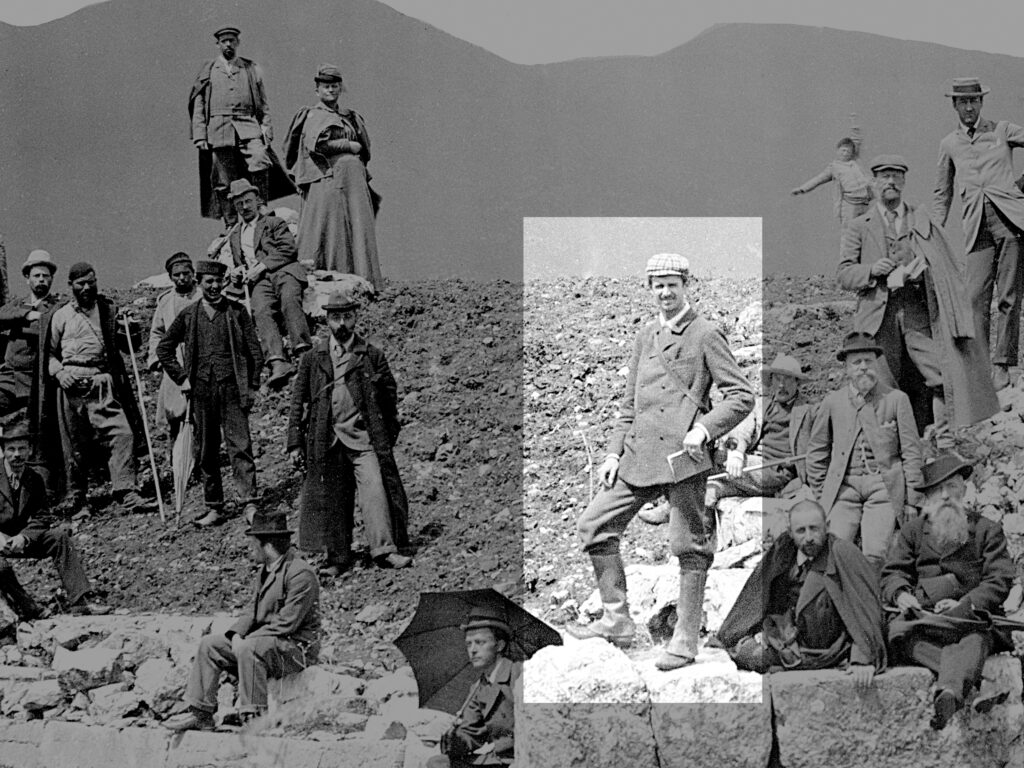
Accounts or pictures of private events and excursions are very rare in the official holdings of the Institute. We owe glimpses of them to the occasional stroke of luck or to later donations of private papers. It thus is very lucky that the entire series of pictures below was made available to the Institute in the private papers of Kurt Ferdinand Müller (1880–1972) after his death.
For Carnival in 1910, the young men at the DAI Athens created unique costumes that still impress today. Georg Lippold and Eduard Schmidt, together with colleagues at the Institute, organized an exhibit of Archaic sculpture, in which they themselves served as the objects on display: Lippold as an Archaic kouros and Eduard Schmidt posing as Nike running with bent knee. The third participant (on the left), who is probably imitating a “Daedalian figure” cannot be identified with certainty. Otto Walter (on the right) completes the group as a museum guard standing behind an inscribed stone (fig. 4).
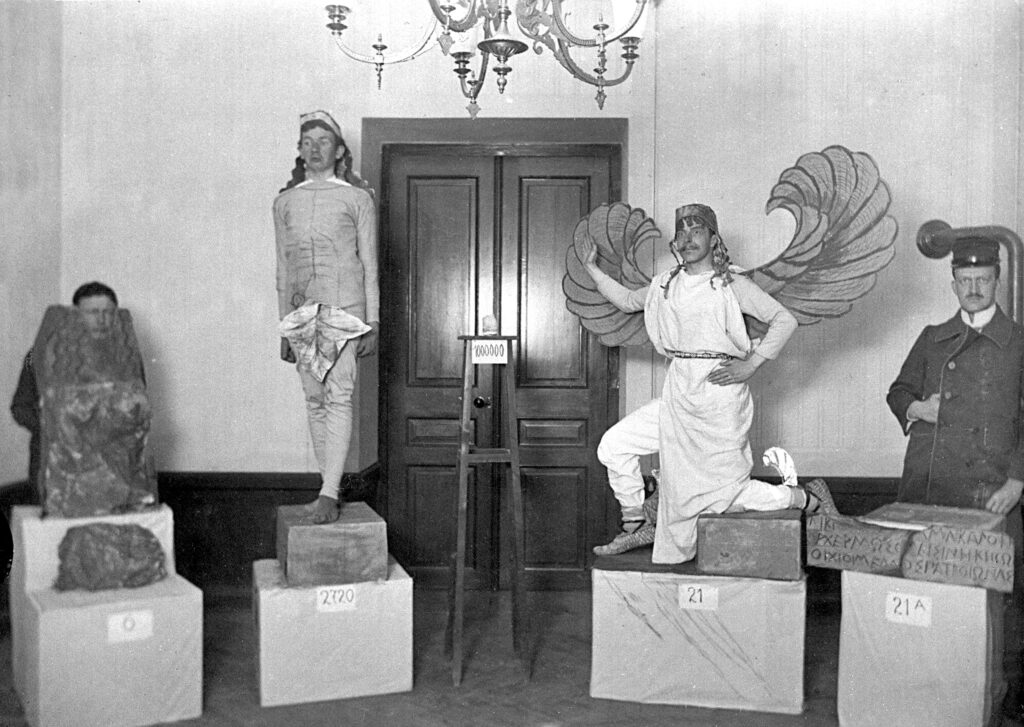
The second picture of the statue group shows how much detail and effort were invested in making the costumes (fig. 5). The date of the photograph, 1910, is inferred from the year in which Lippold spent his travel grant in Greece, which coincided with the stays of the other people in the country. Eduard Schmidt’s costume refers directly to the topic of his dissertation, Running and Flight in Archaic Greek Art (»Lauf und Flug in der archaisch-griechischen Kunst«), which had been published shortly beforehand. Lippold subsequently became one of the leading experts on Greek sculpture.
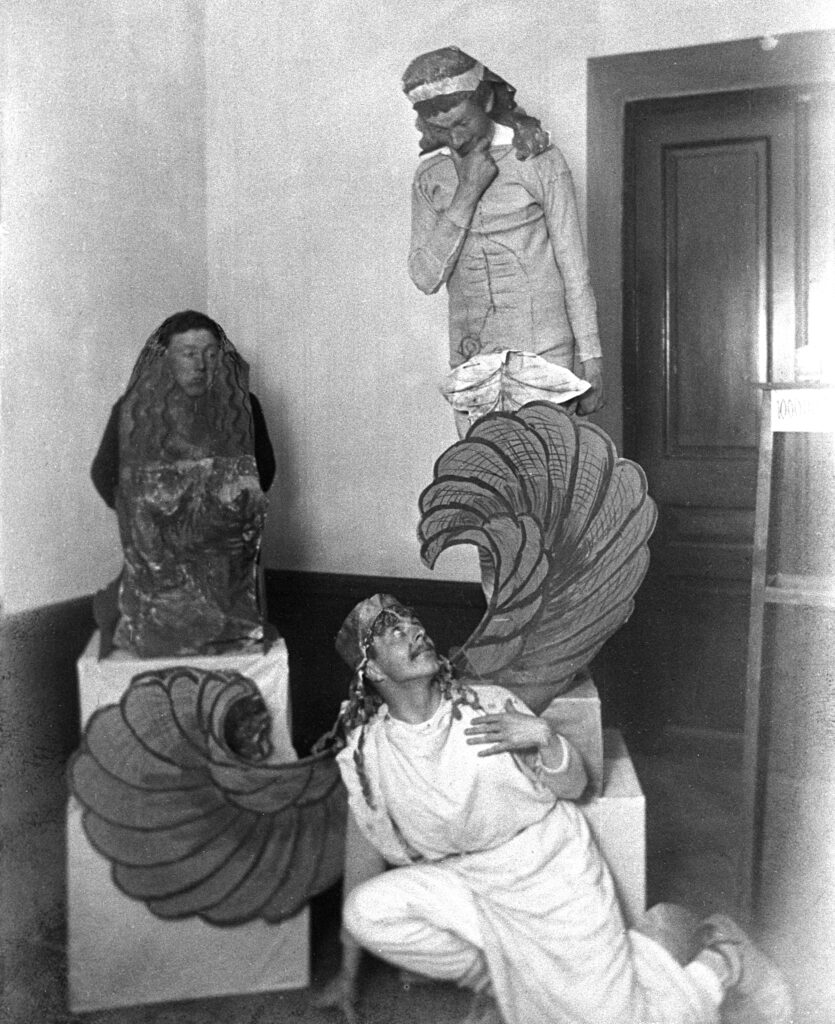
The same people appear on further pictures from Carnival and on pictures from another celebration, both sets of which capture large groups of people. The costumes on the Carnival picture may be much simpler, the atmosphere, however, was obviously quite more jovial (fig. 6). Although not all of the people, some of whom are completely disguised, can be identified, the pictures give us a unique look at a series of archeologists who in some cases rose to important positions later in life. No one at this point in time knew what fate had in store for them or how much world history and, with it, the relationships between them would change leading up to World War II.
The reversal of gender roles was part and parcel with the costume chosen: Gerhard Rodenwaldt, Hugo Prinz, and another person appear as young ladies. Rodenwaldt chose a special hairdo. The person at the far left is dressed as Karagöz, the renowned Turkish-Greek shadow-puppetry figure – very popular at the time. Georg Karo and Adolf Struck (see below) are known to have liked Karagöz-plays a lot. Most of the other costumes are insprired by ancient Greek or Roman clothing, a research-interest especially dear to Margarete Bieber, who was staying at the Institute, too.
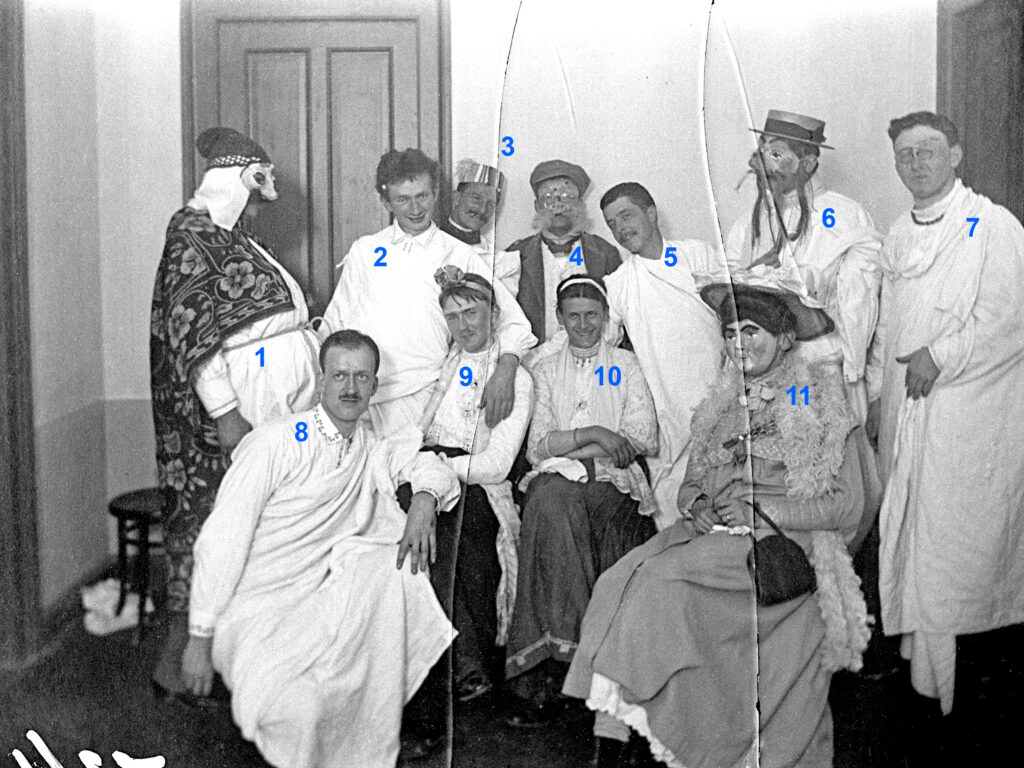
The most plausible candidates for the masked guests are probably among the people on the following photograph, which was taken at approximately the same time and shows many of the people from the group above (fig. 7).
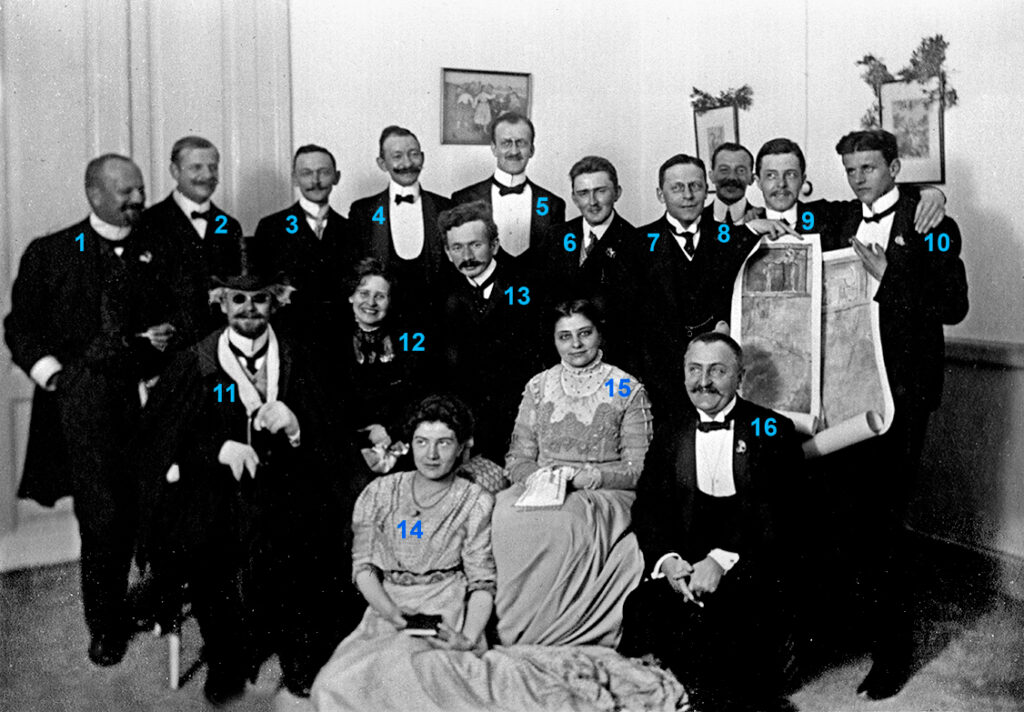
The group in question comprises the academic staff of the department and other classical scholars living in Athens. Numerous pieces of evidence attest to the good atmosphere that prevailed among these people and their friendship with one another. Here, Margarete Bieber sits surrounded by four of the five young men who would later be called her “sons,” namely, her fellow travel grant recipients Rodenwaldt and Lippold, the aforementioned Eduard Schmidt, and Hugo Prinz (Bonfante–Recke 2019, 5; Wiesehöfer 2019, 269–270). Prinz worked in the library of the Institute at this time. Bieber maintained close academic ties with them. She also is known to have played music together with Rodenwaldt. She played the piano that she rented herself and Rodenwaldt sang accompaniment.
The photos of the masked gatherings (fig. 4. 6) above were obviously taken at different events so one might speculate that they were taken in two different years. That does not, however, fit the particular group of people involved, who lived in Athens at the same time only in 1910. We find an explanation, however, in the personal papers of Adolf Struck in the archive of the DAI Athens. He reused invitations to events hosted by “Philadelphia”, that is, the society of Germans living in Greece, which still exists today as the Deutsch-Griechischer Verein, as scrap paper. Invitations to Carnival parties survive in especially large numbers. Since his wife came from the bastion of Carnival Mainz, one might speculate if he was even perhaps a member of the “Pleasure Committee” (“Vergnügungs-Ausschuss”) and thus directly involved in organizing the parties. If we reassemble the halves of the invitations, we find that there were three different festive events for Carnival at the “Philadelphia” in 1907 alone, namely, a ball, to which guests were asked to wear Carnival-themed favors; a subscribers’ ball with speeches on Carnival, and finally a costume ball.
Since we know that the archeologists in Athens were members of the society and regularly attended events at its headquarters at the time in nearby Omirou Street – the same place where the Goethe Institute is located today – we will conclude with a picture of the prettiest surviving invitation, from the year 1909 (fig. 8).
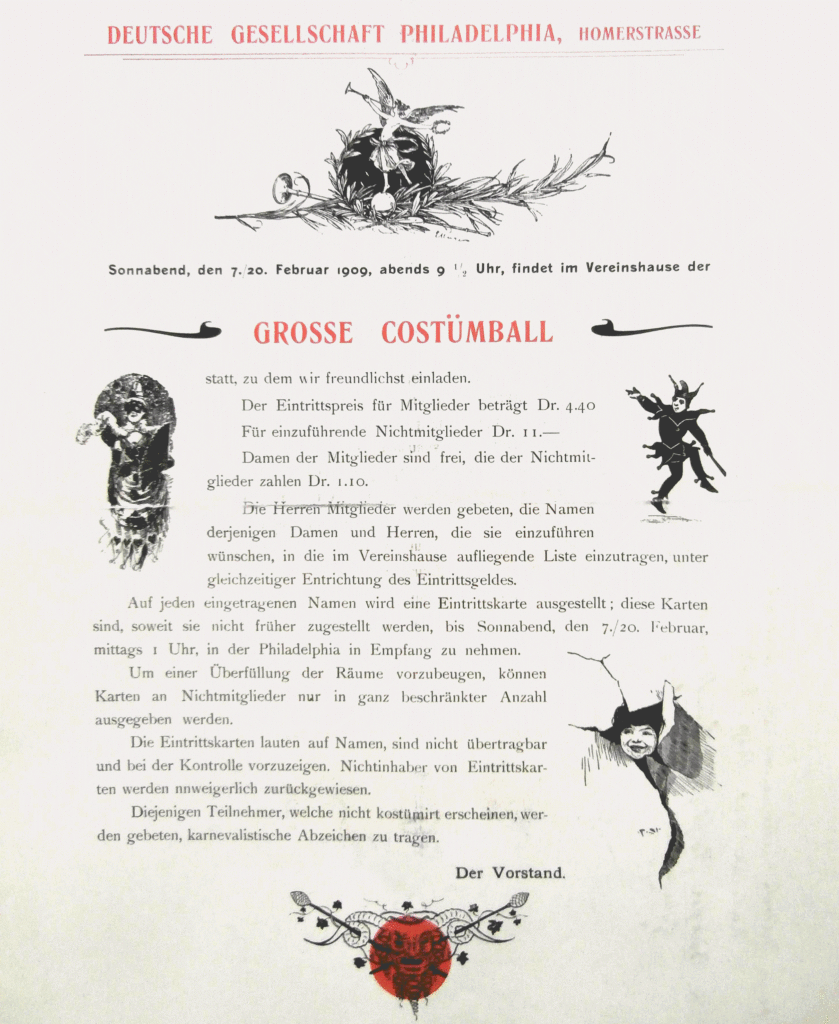
Works Cited and further reading on persons mentioned:
Bonfante – Winkes 1969
L. Bonfante – R. Winkes, Bibliography of the Works of Margarete Bieber for her 90th Birthday July 31 (New York 1969)
Brandt 2019
K. Brandt, Paul Wolters in den Blickpunkt gerückt, AtheNea 2018/2019, 96–97
Bucolo 2019
R. Bucolo, Carneval in Rom – 1914. Archeologia in Maschera, RM 125, 2019, 475 –510
Dragendorff 1895–1897
H. Dragendorff, Reisebericht aus den Jahren 1895–1897 von Hans Dragendorff an seine Eltern, unveröffentlichtes Manuskript (DE DAI-RGK-A-Fa-Drag-04)
Dragendorff 1903
H. Dragendorff, Thera: Untersuchungen, Vermessungen und Ausgrabungen in den Jahren 1895–1902 (vol. 2): Theraeische Gräber (Berlin 1903)
Drerup 1939
E. Drerup, Aus versunkenen Tagen – Jugenderinnerungen (Paderborn 1939)
Graml 2016
C. Graml, Adolf Hermann Struck (1877-1911). Von der Orientbahn ins Deutsche Archäologische Institut, in: R. Witte (ed.), 11. Internationales Kolloquium anlässlich des 125. Todestages Heinrich Schliemanns ‘Archäologie und Archäologen im 19. Jahrhundert’. Mitteilungen aus dem Heinrich-Schliemann-Museum Ankershagen 10/11, 2016, 426–447
Hallof 2012
K. Hallof, Inscriptiones Graecae. Emagines Epigraphicorum – Epigraphikerbildnisse (Berlin 2012)
Matthaiou – Malouchou 2004
A. P. Matthaiou – G. Malouchou (ed.), Αττικαί επιγραφαί : πρακτικά συμποσίου εις μνήμην Adolf Wilhelm (1864–1950)
Recke 2013
M. Recke, Margarete Bieber (1879–1978) – Vom Kaiserreich bis in die Neue Welt: Ein Jahrhundert gelebte Archäologie gegen alle Widerstände, in E. Fries – D. Gutschmiedl-Schümann (ed.), Ausgräberinnen, Forscherinnen, Pionierinnen – Ausgewählte Porträts früher Archäologinnen im Kontext ihrer Zeit, Frauen – Forschung – Archäologie 10 (Münster 2013) 141–149
RGK 2020
Römisch-Germanische Kommission des Deutschen Archäologischen Instituts (ed.), Mehr als nur Scherben… Hans Dragendorff als Forscher und Wissenschaftsorganisator (Frankfurt am Main 2020)
Wiesehöfer 2019
J. Wiesehöfer, Hugo Prinz: Ein althistorischer ‘Wanderer zwischen den Welten’, in: Johannes Fouquet et al. (eds.), Argonautica. Festschrift für Reinhard Stupperich, Boreas Beih. 12, 367–375
Wlach 2019
G. Wlach, Camillo Praschniker (1884–1949). Wiedergewinnung aus der Zerstörung, 313– 377, in: K. Hruza (ed.), Österreichische Historiker. Lebensläufe und Karrieren 1900–1945, vol. 3. (2019)
Weblinks to persons mentioned:
Margarete Bieber
L. Bonfante – M. Recke, Margarete Bieber (1879–1978): Two Worlds.
Paul Groebe
https://d-nb.info/gnd/117563633
Georg Karo
C. Schwingenstein: Karo, Georg, in: Neue Deutsche Biographie(NDB) 11, 280 f. https://daten.digitale-sammlungen.de/0001/bsb00016328/images/index.html?seite=294 (accessed 25 February 2023)
Georg Lippold
W. Grünhagen: Lippold, Georg, in: Neue Deutsche Biographie 14 (Berlin 1985) 668 f. (accessed 25 February 2023)
Eduard Schmidt
https://cau.gelehrtenverzeichnis.de/person/109a0b52-8984-095d-ad63-4d4c6064992b (accessed 25 Februar 2023)
Hans Schrader
W. Raeck: Schrader, Hans.In: Neue Deutsche Biographie(NDB) 23, Berlin 2007) 508–510 (accessed 23 Februar 2023)
Anton von Premerstein
https://www.biographien.ac.at/oebl/oebl_P/Premerstein_Anton_1869_1935.xml (accessed 23 February 2023)
